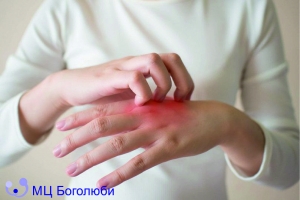Eczema – is an inflammation of the skin, the typical manifestations of which are the formation of bubbles resembling boiling water. From here comes the name of the disease - from the Greek «exeo», which means «to boil».
According to statistical studies, about 4% of the world's population suffers from eczema. It affects mainly young people, women are sick more often than men. Interestingly, from the middle of the last century, the incidence of eczema has been increasing, and over the years the disease has become more common. It was also found that about 10% of patients are medical and social workers.
Types of eczema
There are several types of eczema, each with its own characteristics, which only experienced experts can recognize. Therefore, self-medication is unacceptable. In case of skin problems, any questions and doubts, you can turn to a consultation with qualified and experienced specialists of the Bogoliuby MC. .
The most common types of eczema are atopic, seborrheic, contact, and asteatosis. Less known are discoid and varicose, dyshidrosis, herpetiform dermatitis, perioral dermatitis and neurodermatitis.
Reasons of eczema
The causes of eczema are currently being studied, since researchers have not yet figured out what exactly triggers the inflammation of the skin. The most popular theories blame ecology and the genetic factor. Some scientific data link the occurrence of eczema with an allergic reaction to certain substances, a bacterial or fungal infection. It should be noted that in patients with celiac disease, eczema develops three times more often than in people without this disorder.
Analyzing the genetic profile of numerous patients with eczema, scientists noted that the expression of some specific genes in them does not occur as usual. Among the genes that affect the presence of certain types of disease, filaggrin, a protein found in the epidermis that binds keratin filaments, deserves special mention. In addition, paying attention to family history, it was found that the disease was a constant problem in different generations.
Thus, these two discoveries led experts to the conclusion that in some cases eczema has a genetically inherited basis.
Symptoms and complications
As already mentioned, a characteristic sign of eczema is a rash. However, the disease can manifest itself without specific blisters. The affected area is limited to redness, itching, swelling and dry skin. Purulent lesions are often developed. The characteristics of the rash are highly dependent on the type of eczema.
The following areas are most commonly affected: neck, arms, wrists, forearms, legs, and ankles. At the genital level, an eczematous rash is extremely rare.
Complications of eczema are often associated with very severe itching. An unpleasant sensation causes a person to rub his skin repeatedly, causing scratches and abrasions. These skin lesions become the entrance gate for various types of microorganisms. The ingress of bacteria can cause an infection, the typical symptoms of which are fever, pain, pus.
Diagnosis of eczema
In general, for a proper diagnosis of eczema, a physical examination and assessment of a family history is necessary. Sometimes, specialists resort to allergy tests and skin biopsies when doubts arise regarding the type of eczema.
Treatment and Prophylaxis
A feature of the eczema treatment is that effective therapy for one patient can be completely useless for another. However, in the general context, the treatment of this disease involves the use of emollients and various medications, including:
- corticosteroids (for local or oral administration, the two main corticosteroids used in eczema are hydrocortisone and clobetasol propionate);
- immunosuppressant (facilitate the inflammatory response by reducing the response of the immune system);
- antibiotic;
- antihistamines (block the release of histamine, reducing itching and irritation).
Herbal medicine may be very effective for some types of eczema. Preventive measures for eczema include timely treatment of infectious foci in the body, careful observance of hygiene standards, the exclusion of alcohol and nicotine, spicy, salty and acidic foods. Negative consequences may have contact with household chemicals.

















